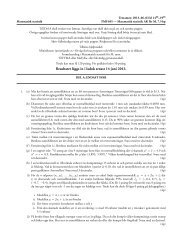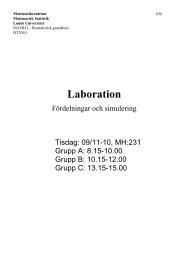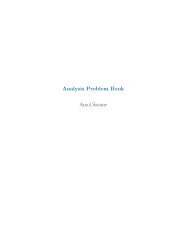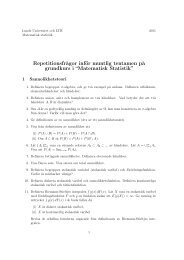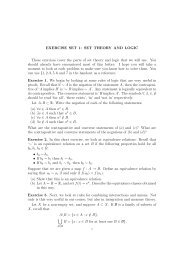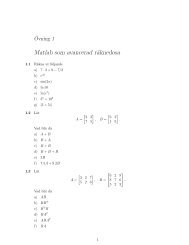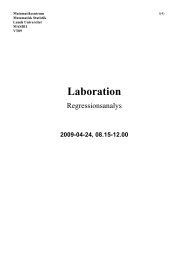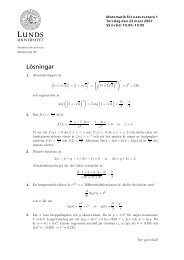Correspondence of Marcel Riesz with Swedes. Part II. file: Riesz1.tex
Correspondence of Marcel Riesz with Swedes. Part II. file: Riesz1.tex
Correspondence of Marcel Riesz with Swedes. Part II. file: Riesz1.tex
You also want an ePaper? Increase the reach of your titles
YUMPU automatically turns print PDFs into web optimized ePapers that Google loves.
0.17. FOLKE ODQVIST 49<br />
skolpojkarna smäller ryska smällare för dig, samt om det gängse akademiska<br />
skvallret. Min vördnad till dina föräldrar. Hälsa Ekman gott nytt år!<br />
Tillgivne Folke X.<br />
Translation:<br />
Dear brother Håkan, Exiled in the country <strong>of</strong> the barbarians, I write to you in a<br />
purely egoistic purpose. Namely, in the investigation <strong>of</strong> a 2-dimension/al hydrodynamical<br />
problem for a viscous fluid I was led to the following problem: Find the sequence <strong>of</strong><br />
continuation functions that map (see Figur ) the domain (2) between the circle C and<br />
the real axis onto the halfplane X and haves a singularity <strong>of</strong> order n i z = infinity.<br />
The simple case when the singularity is a branching point, apparently, can be treated <strong>with</strong><br />
but for n ≥ 1 one gets X <strong>of</strong> the form<br />
X =<br />
X = log z − iα<br />
z + iα<br />
a −n<br />
(z − ia) n + · · · + a −1<br />
z − ia + a 0 + a 1 (z − ia) + . . .<br />
Next one asks. Has anybody treated this system <strong>of</strong> functions 32 If you do not know it<br />
yourself ask <strong>Riesz</strong> or Carleman or another reliable person!<br />
I work at full speed <strong>with</strong> experiments which yp to now have beem successful. I add a<br />
copiw where the dashed portion is precisely the vortex domain predicte in my licentiate<br />
thesis.<br />
Moreover, I have been corresponding <strong>with</strong> Oséen 33 , who apparently has approved as<br />
a theme for thesis: Mutual influence between heat conductiong and liquid flow. It is an<br />
application <strong>of</strong> the method <strong>of</strong> Lamb <strong>with</strong> “solid harmonics” in a special (experimentally<br />
treated by Burgers) that led me to the issue mentioned.<br />
32 As you see immediately, one gets X = (z + 1 z )n if the straight boundary/ line is allow<br />
to stretch out to infinity and the coordinate system is moved in a suitable manner.<br />
33 Oséen, Carl Wilhelm, 1879-1944, pr<strong>of</strong>essor <strong>of</strong> mechanics and mathematical physicc<br />
since 1909 at UU, one <strong>of</strong> the founders <strong>of</strong> the Swedish Society <strong>of</strong> Physicists and its first<br />
Chairman. O’s in part pioneering activities covered hydromechanics, electromagnetism<br />
and optics, for example the Ewald-Oseen extinction theorem, describing the refraction <strong>of</strong><br />
light at the limit surface for a rigid body as a diffusion phenomenon. O. explained further<br />
the d’Alembert paradox, that is that resistance <strong>of</strong> liquids <strong>of</strong> low viscosity theoretically was<br />
negligible, in contrast to the experimental experiece. O. was one <strong>of</strong> the first to present a<br />
theoretical explanation <strong>of</strong> the behaviour <strong>of</strong> floating crystals. [114].




